In Japan’s Serene Kōchi Prefecture, Experience Kintsugi for the Soul
This website uses affiliate links which may earn a commission at no additional cost to you. As an Amazon Associate I earn from qualifying purchases.
Updated: 18th January 2020
Kintsugi is a word held dear in Japanese culture. It’s the art of mending cracked or shattered items, such as porcelain or bone china. Artists glue the fragments together with gold leaf or urushi lacquer, and once ‘healed’, the restored object is no longer deemed damaged. Instead, the new imperfect presentation is revered. The supplementary gold decoration is seen as another layer of beauty rather than a reminder of an unlucky accident.
Often, I think we humans need to perform a rendition of this 16th-century art form on ourselves. Not in the hospital sense of fixing, say, a broken finger with gleaming embellishment. Rather, in mending the ailments of our mind. Healing the cracks of a chaotic, fast-paced world with exquisite new internal detailing. If you will.
Unbeknown to me, Japan’s Kōchi prefecture, the southernmost of Shikoku Island’s four regions, would be my much-needed kintsugi. It would be a pilgrimage for my soul, a healing for my heart, and an unexpected lesson in letting it all go.
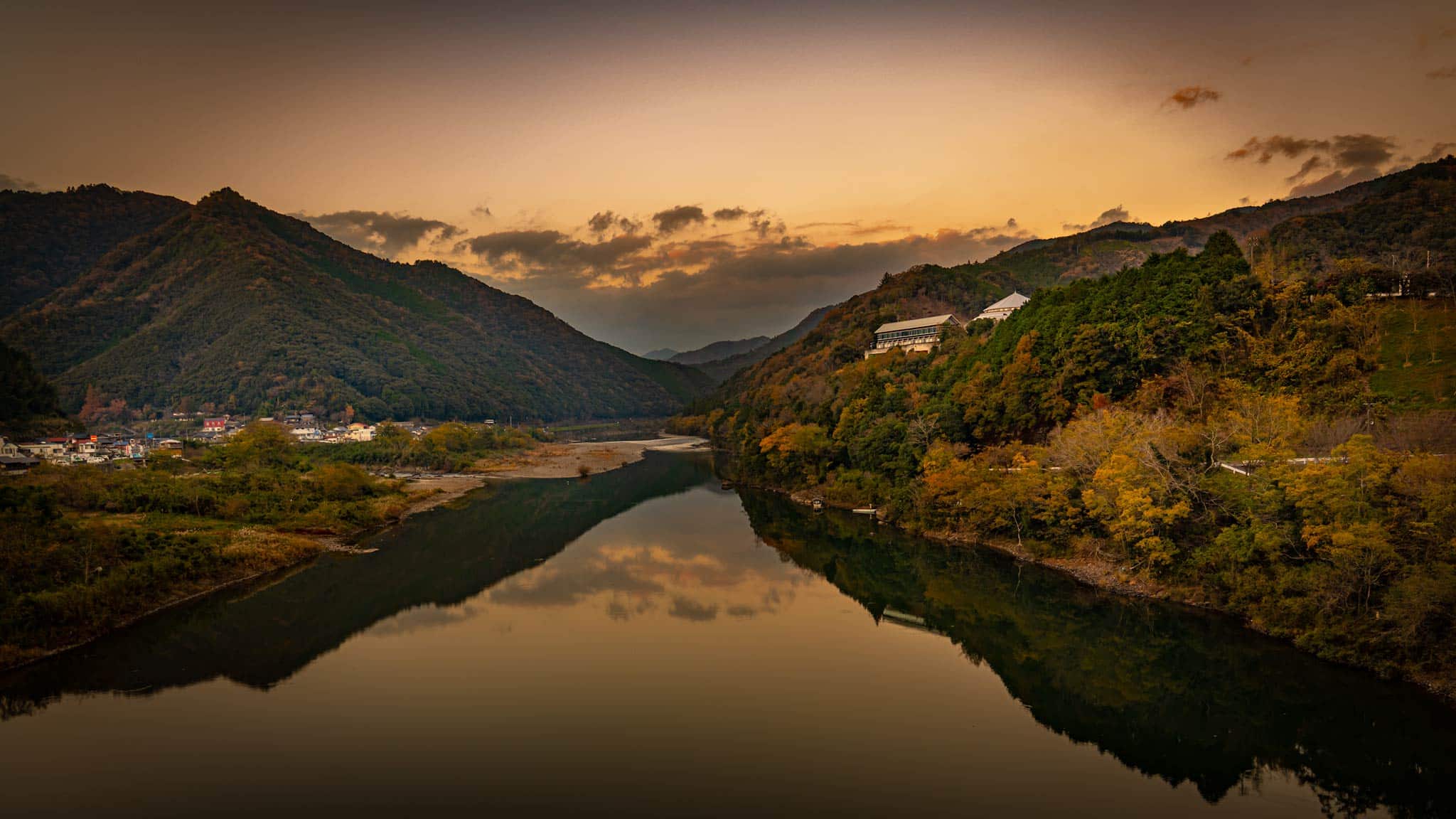
Another Japan
Arriving in Kochi, you quickly understand that you’re a world away from Tokyo’s towers and overloaded transport. It’s a calming cradle of temples, tea houses, and unadulterated time. Pilgrims flock here to traverse some 80 precious pagodas. Traditional knife-making workshops hide away in almost hibernating villages. And mirror-like rivers slice through forested banks – a turquoise slither of countryside kintsugi.
In fact, some provincial streams are so clear and celebrated that one waterway even gifted Japan a new anointed colour: Niyodo Blue.
Yet somehow, the prefecture remains unsung, even with a growing trove of “wellness offerings”. Something it seems tourist boards worldwide have decided to hawk as the next travel trend.
But maybe they’re onto something. Wending along the highway, with fresh autumnal air flooding through the window and a copper canopy on the horizon, I felt serenity. And I hadn’t even reached my “deep seawater therapy resort” yet. Thoughts of Tokyo faded. Home was even more distant. And not even the intermittent sight of a tsunami tower was phasing me.
Here on Route 55 – think of it as Kochi’s coastal version of Route 66 – I was getting my first stroke of kintsugi. Albeit in concrete rather than 24 carat.
Pulling into a small parking lot, marked by an almost missable sign, a hut lined with wellington boots greeted me. Grabbing the largest pair I could find, I slipped out of my trainers and crossed the road. Only in Japan could the seemingly remotest of attractions care about your footwear not being damaged, I thought.
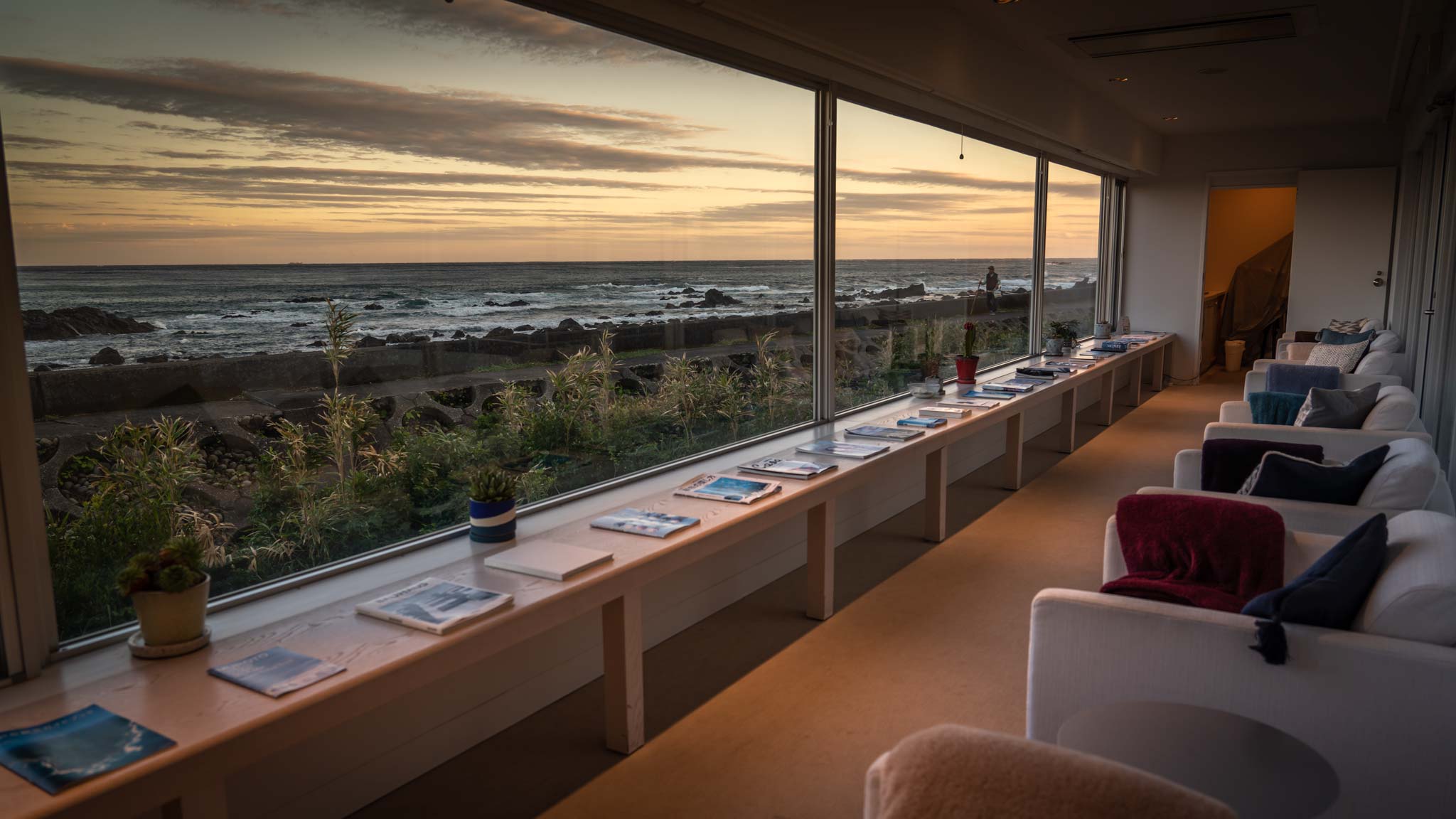
The Ioki cave has been carved out by the sea over centuries, a testament to the power the ocean commands here. It’s somewhat surprising that just seconds from the highway you can step into a cave and instantly feel transported to a rainforest of dripping ferns, towering bamboo, and the light trickling of water, which further upstream turns into a fair-sized waterfall.
I follow the one-way route, as this is Japan and organisation reigns supreme, and a strange scenario greets me. A stuffed doll sits at a table eating a meal, while the rest of the stuffed doll family is scattered around on chairs. That’s a solid 14/10 for the Kochi scarecrows, shaming the stick-like figures we have back home.
Returning the boots to the hut, the energetic caretaker, who simply didn’t look his stated age of 90, asked me to sign the visitor’s book. Dutifully, I obliged, before skipping back through all the pages and seeing I was the first not to write in the Japanese scripture.
This is what travel is all about, I thought, as I signed my name, proudly to be the first Portuguese resident registered in the Ioki visitors book.
With the jet lag battle ongoing, and only about five hours sleep achieved in the past few days, my heavy head was met with a full heart as the road wound by to the Utoco Resort, complete with a deep-sea therapy centre and spa.
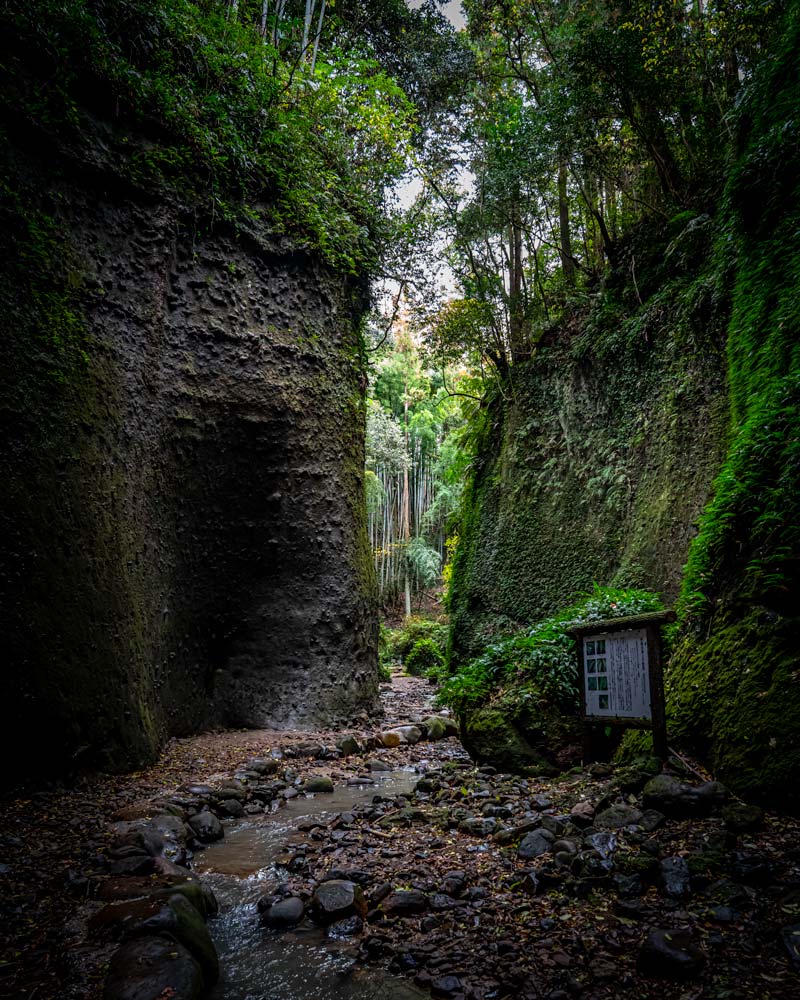
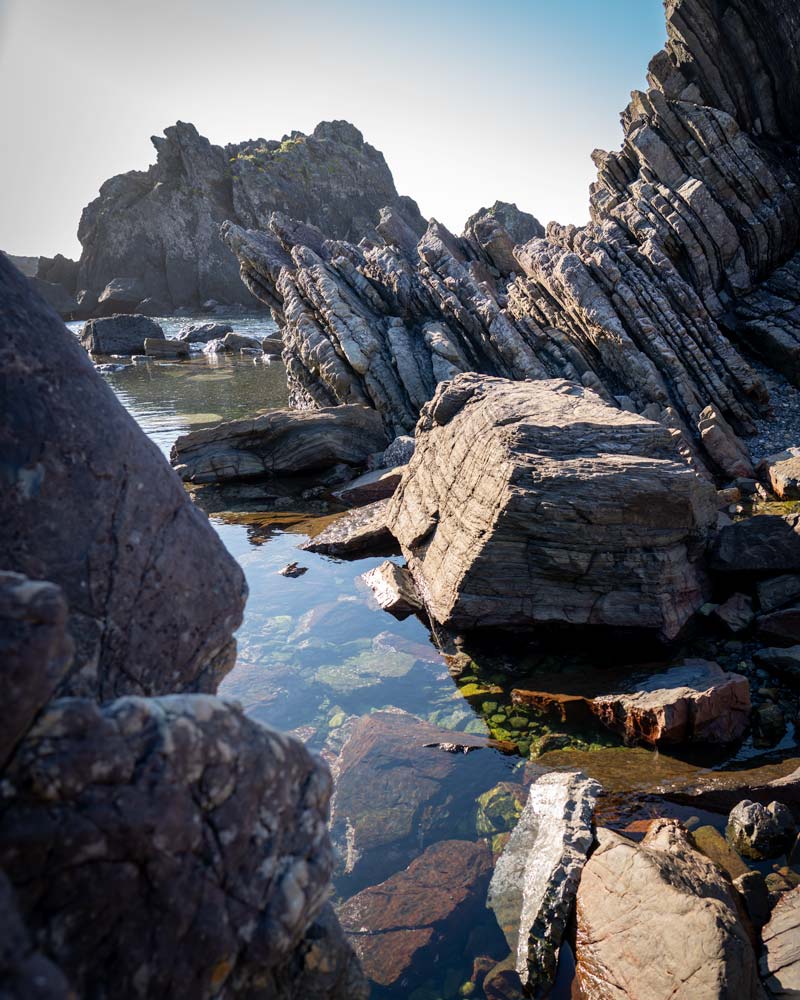
Soothed by seawater
While this wouldn’t usually be my normal type of accommodation, the idea of a pamper had sounded inviting, and now my tired and delirious head had set eyes on it, I decided I certainly wouldn’t want to check out in the morning!
Utoco blends in perfectly in its surroundings, the striking Muroto Global Geopark. A land of dramatic rock formations, thundering coastline, and dense trees broken by the occasional Buddha, it’s the perfect place to recharge the mind and the body.
The all-white building offers oceanfront views from every single bedroom, with spacious bathtubs pressed against the windows, and large double beds and sofas offering equally primetime vistas. For extra points, there is also a rooftop terrace and even a library, with soothing music and herbal teas, and individual lounge chairs facing out to the ocean.
Knowing Japanese cuisine, I expected dinner to be a delight, but the seemingly never-ending menu surpassed all expectations. From roasted lobster to local Tosa-Duck, each course blended the flavours perfectly and provided a balanced and healthy dinner, set against the stunning sunset backdrop in the zen dining room.
At two am jet lag stirred me from the luxurious bedding, and I stepped out into the cool breeze of the balcony. With nothing for miles around, the stars twinkled in the sky and a few hours late, the first moments of sunrise appeared. Muroto is special in that at the tip you can see both sunset and sunrise.
As part of the Utoco resorts complimentary activities programme, I joined a sunrise yoga class inside the pool hall. While the class was obviously in Japanese, I think I followed along pretty well, except on the close your eyes and relax bit, as the most breathtaking sunrise was continuing against the crashing waves, and I didn’t want to miss a second of it.
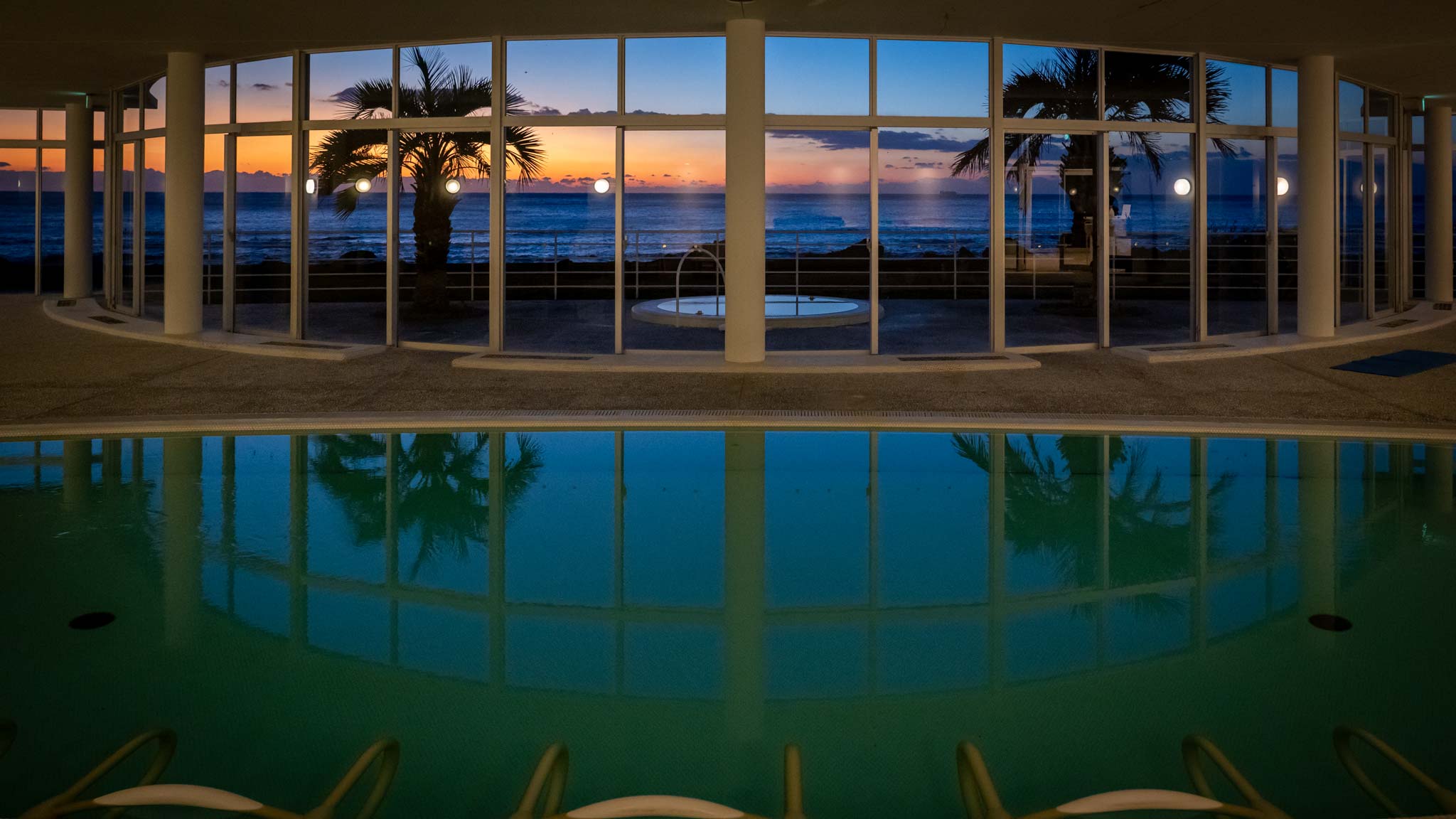
As part of the hotel complex, there is a deep seawater spa, a concept that I’d never heard of before, but this soothing deep seawater filled both the heated to body temperature swimming pool with panoramic windows and the outside jacuzzi.
Muroto has an unusual topography underwater, which dramatically and quickly drops off to a depth of around 1000 metres. It’s from here the deep ocean water is pumped up to the spa. The water is revered for its cleanliness, as at that depth it can’t photosynthesise, and the high mineral count adds to the soothing powers. It’s said to penetrate the body quicker and thus relax muscle tension. I felt like I was floating in the pool, and although the science may have been slightly lost on me, the feeling of tranquillity within my body wasn’t.
Breakfast was just as lavish as the dinner before, with six different courses, and as I peacefully started my day, drinking Yuzu juice and eating fresh fruits and baking, I realised how long it had been since I felt this relaxed. I’m often guilty of seeing accommodation as mere bricks and a bed, but here I was reminded of just how important it is sometimes to treat yourself, especially in the chaotic world many of us live in.
Reluctantly checking out, I hired one of the bikes from reception to explore more of the Muroto, an official UNESCO listed Global Geopark. The rock formations, created through thousands of years of water pressure, were only a small part of the areas beauty. Pools of water, unique flora and fauna, and the little temples and Shinto shrines added to the pristine and relaxing vibe of the area.
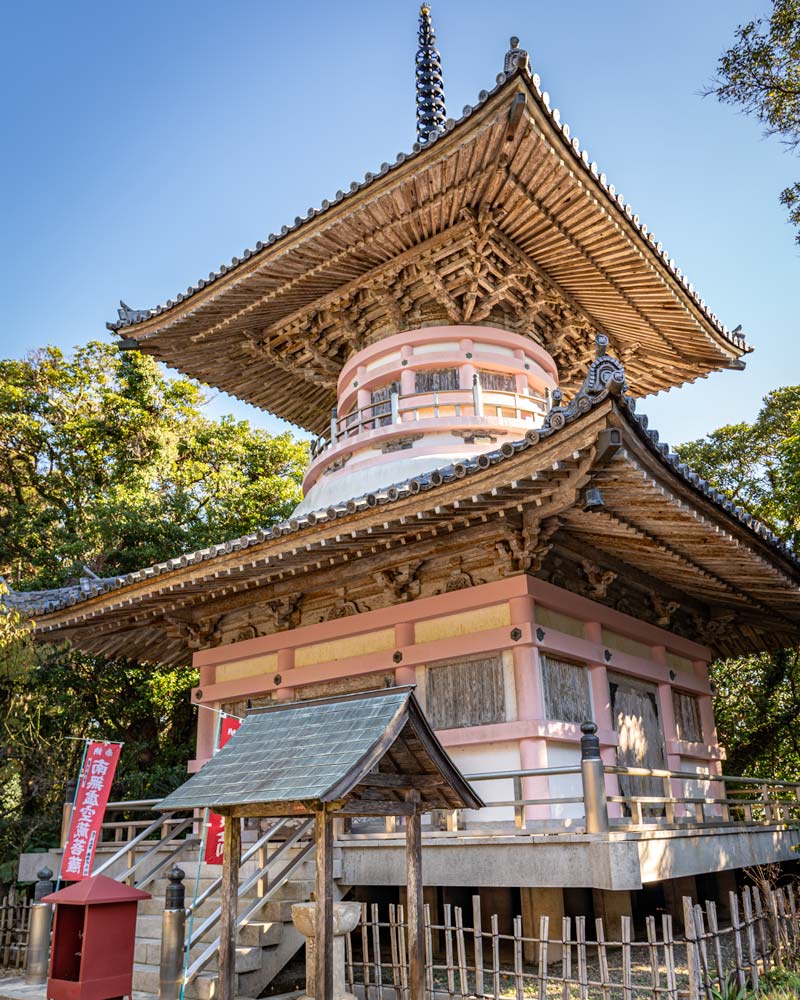
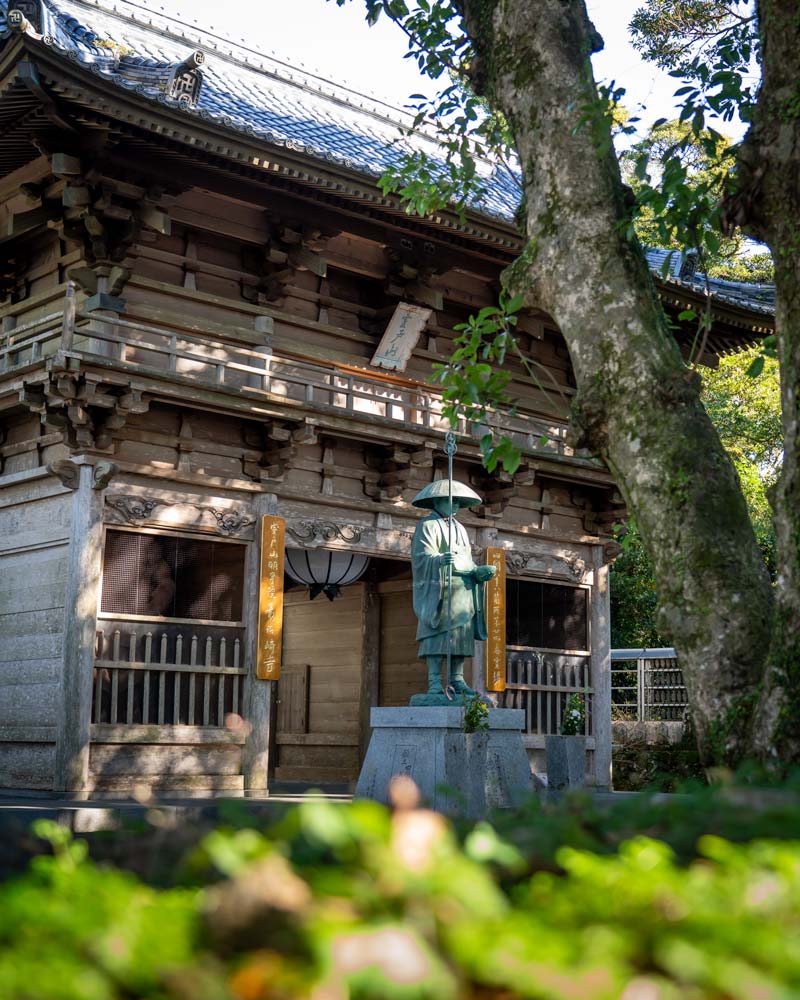
Pilgrims and passengers
High above the park, hidden amongst the forest and set back from the lighthouse was Hotsumisakiji Temple. From here, the views of mother natures work were sublime, and the temple itself another tranquil setting.
Hotsumisakiji is the 24th temple on the Shikoku Pilgrimage route, something which I’d been keen to get on board with before my visit. During the planning stage, however, when I realised it wasn’t a one-day affair, but a pilgrimage of over 1000-kilometres, I decided visiting a few of the temples would do me just fine. Their white outfits and conical hats can note the pilgrims on this route, and I was told the reason the region was so well known for their welcome and hospitality was the hundreds of years of receiving and supporting these pilgrims.
The temples in Japan are rarely just singular structures, but often make up various gates, prayer halls and outside spaces, and Hotsumisakiji is no different. The caretaker smiled and waved me over to ring the drum, an action the pilgrims would take before proceeding, and one I gladly, though slightly guilty did, having taken a car ride up here.
After stopping off for some fresh baked goods from a small bakery, where a cheery faced lady proudly showed off her pre-war oven, I boarded a very special train journey at Nahari station. The single-track line which runs along the coast of Kochi offers the chance to feel the sea breeze on select journeys and services throughout the day, with open-decked trains that slowly follow the shoreline.
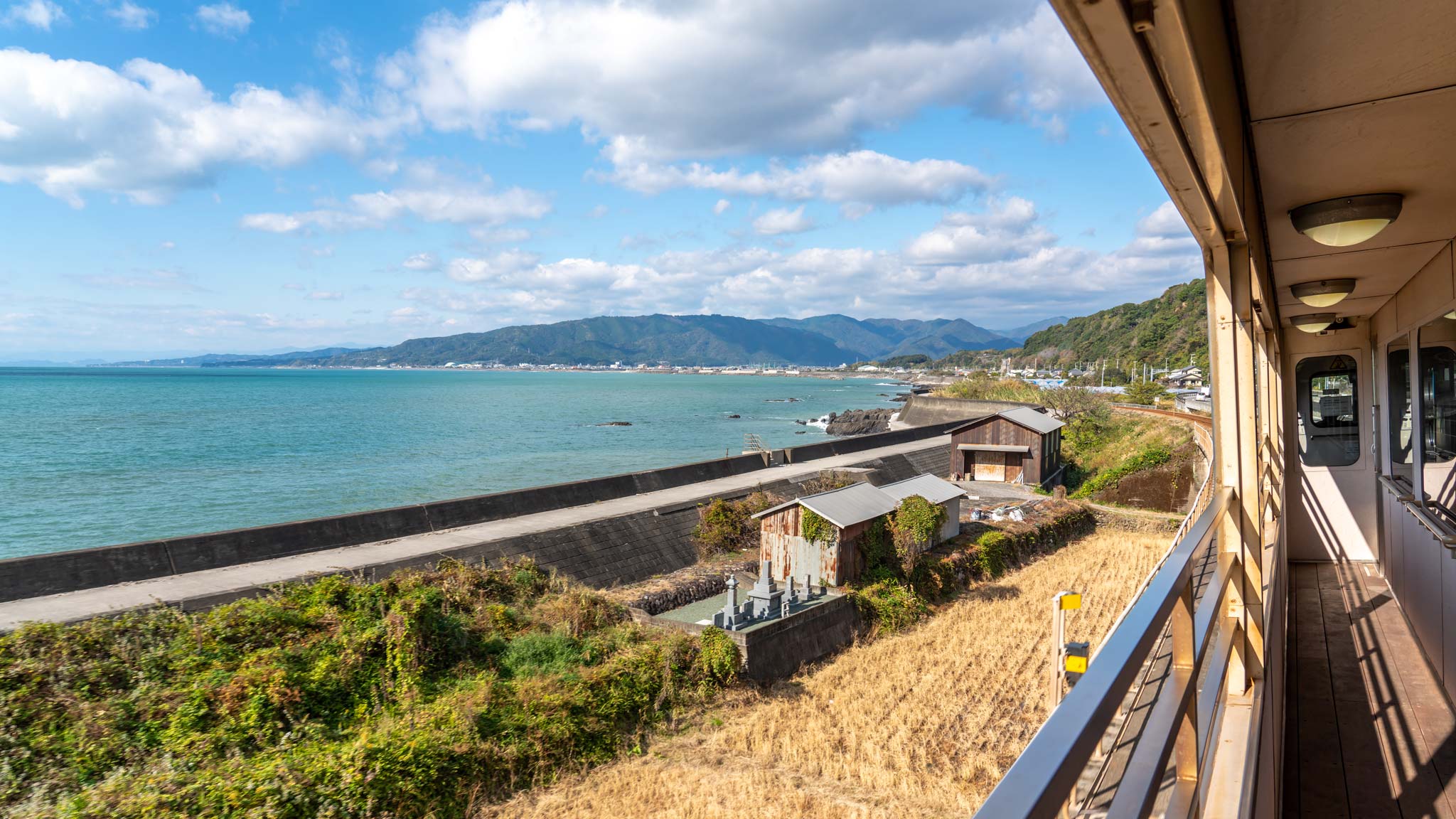
Once the engines are rolling, the conductor signals that you are free to leave your seats and slide open the doors, stepping out onto a side deck which is open to the elements. Gliding along, the gentle ocean air greets you, as small farming communities and empty patches of greenery interpret the sea views. Occasional, a tunnel will take you by surprise and steal the peacefulness, but quickly you are returned to nature.
While you can follow the train line much further, I disembarked at Nishibun Station as my friends at the tourist board had wanted to take me to a special place for lunch. As soon as I set eyes on Sea House, I understood why.
Jutting out over the side of the cliff, this glass box restaurant was striking. Inside, windows on all sides perfectly framed the silvery sands and bright blows of the ocean below. It was an ‘Instagrammers’ paradise, but blissfully, bar one other family, we were the only guests there. We sat at the horigotatsu, a traditional Japanese table low to the floor meaning we were rested on cushions, and admired the view as the sun warmed our backs. I was so taken back when the server came for my order, having entirely forgotten about eating. While the food was good, I don’t think anything could have been as delicious as the views.
While much of the Kochi Prefecture can be travelled by public transport, my hosts offered to give me a lift onto my next accommodation. Sadly, due to a problem with the booking, I wasn’t able to stay at Yu No Mori, a stunning riverside Onsen hotel next to the Nakatsu Valley, my starting point for the following day, and instead settled into a hotel in the city before carrying on. However, given how gorgeous of a location this traditional hotel holds, and having been able to visit it the next morning to take a peek, it’s somewhere I’d highly recommend rather than interrupting your peaceful journey with a city detour.
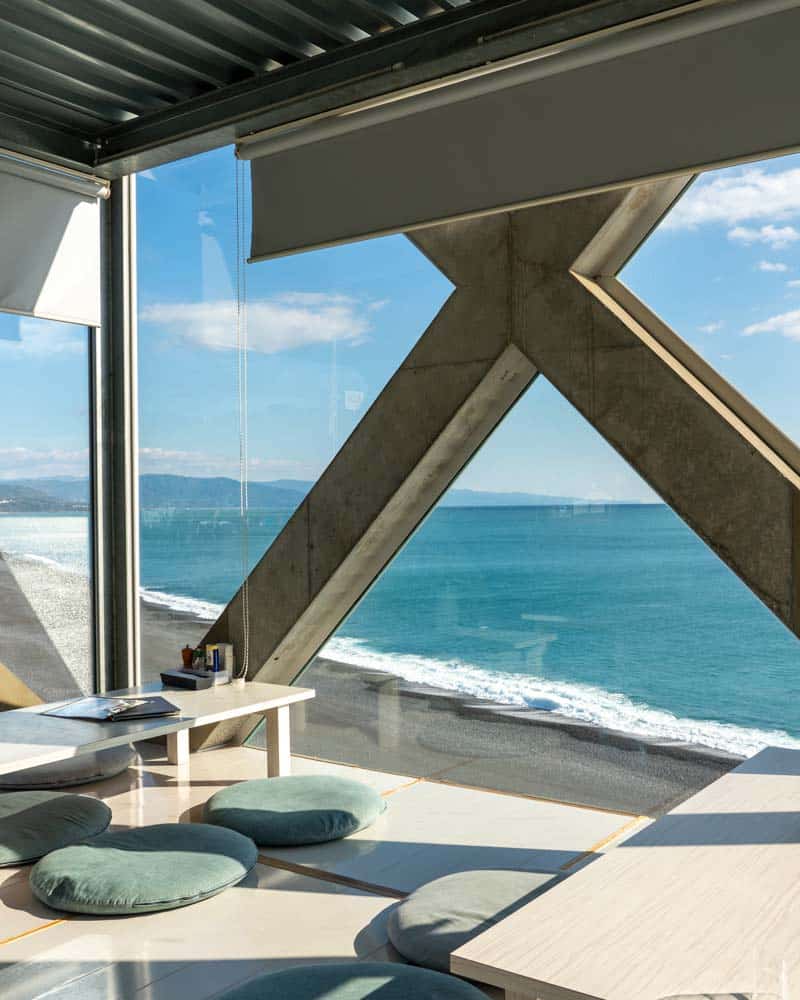

A new shade of blue
The Nakatsu Valley is characterised by Niyodo Blue, a colour shade that shimmers both blue and green, and was named by photographer Nobuyuki Takahashi. Needless to say, whatever name you want to give it, it is known as some of the purest and cleanest waters in the whole of Japan.
The Niyodo River and surrounding area are well known for their water sports, natural hiking and uninterrupted nature – making it a popular spot for camping alongside wellness hotels. With my plans to spend my water sport time at the Shimanto river, I only dedicated part of the day to delve into these famed waters at the Nakastu Valley.
Taking around two hours to hike into and return from, the wide canyon of rocks and dense trees breakaway for the crystal clear waters to trickle through. Occasional pools hold the body of water, while different Buddhist symbols and statues can be spotted on the route. After climbing some carved out stairs, we arrived at the endpoint, a gushing waterfall throwing all its power down the purple rocks, tinted by the natural elements within the stone.
Full disclosure: my hosts had learnt one of the reasons I had wished to travel by public transport is that I don’t drive myself (the other main reason is I love public transport) and thus had in true Japanese manners deemed it necessary to continue driving me during the trip, which was obviously terribly kind. The bonus of this was that I could pack a lot more places into my visit, but it also means if you are planning your own visit to Kochi, you’ll either want to hire a car to follow my exact route or adapt and slim it out to make it work by public transport, all of which I’ll cover in my more practical Kochi Japan travel guide.
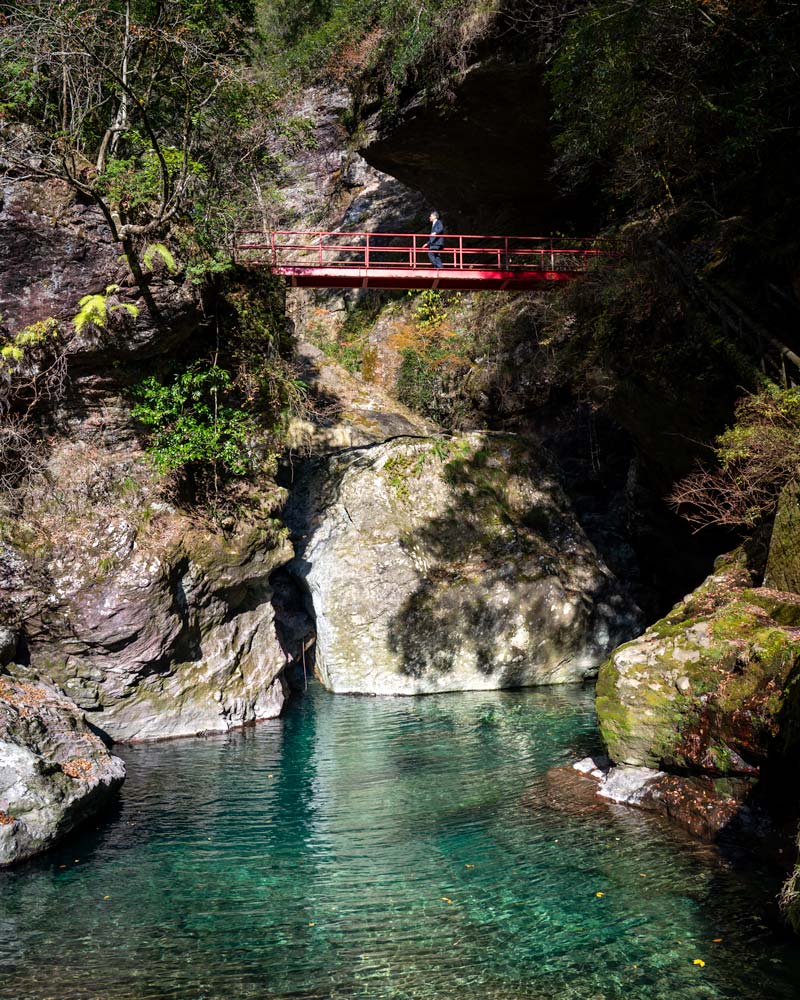
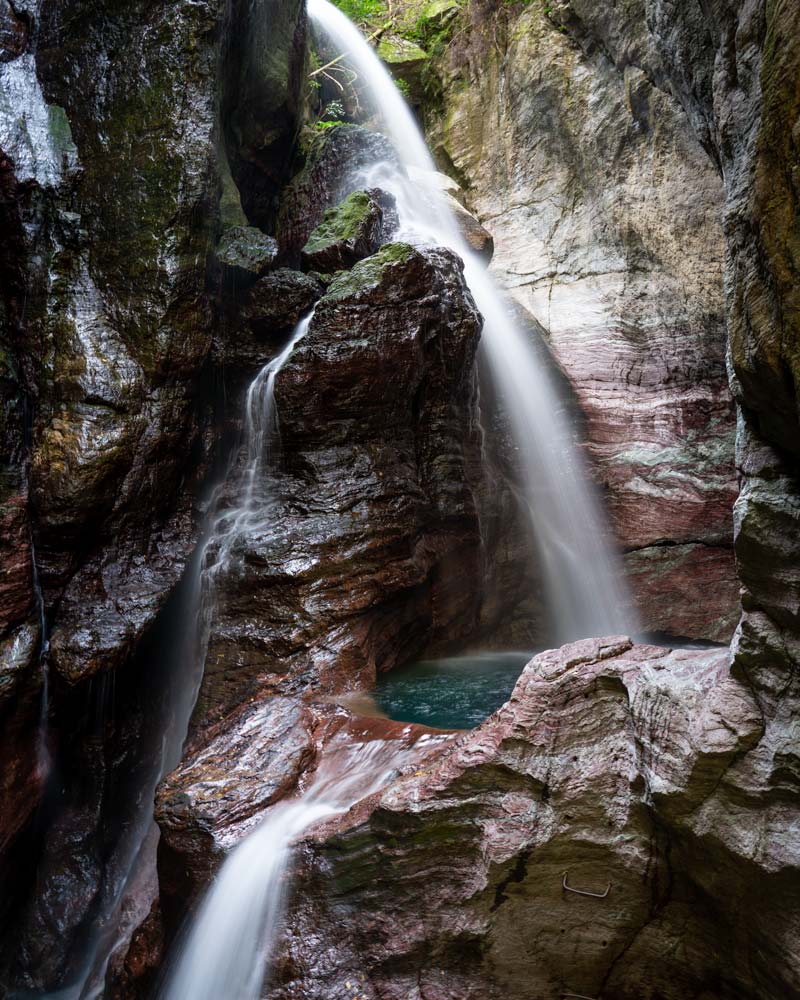
As we wound up the mountains roads, I could see terraced lines of green across the valley and assumed they were rice terraces. At lunch, I would learn they weren’t, but Matcha, which was much more than a popular tea here.
With an abundance of Matcha in the prefecture, the health benefits of this ground-up leaf went far beyond your standard cuppa. Innovative locals were using it in all sorts of ways, including in their noodles.
At Asunaro, a cafe which commanded an impeccable view of the terraces, mountains and a vast lake, we braved the outside winter temperatures wrapped in blankets to appreciate the vistas fully. The tasty green both with thick juicy noodles we were served was exquisite, and the high antioxidant, metabolism-boosting, mind-calming Matcha dish went down a treat.
Driving higher into the mountains, the dense forest parted to wide-open lands strewn with rocks. We were close to the border of the prefecture, and parking up at the hotel, I learn quickly that if you stayed here, you would check in to Kochi, but sleep in a different region as it cut right across the border.
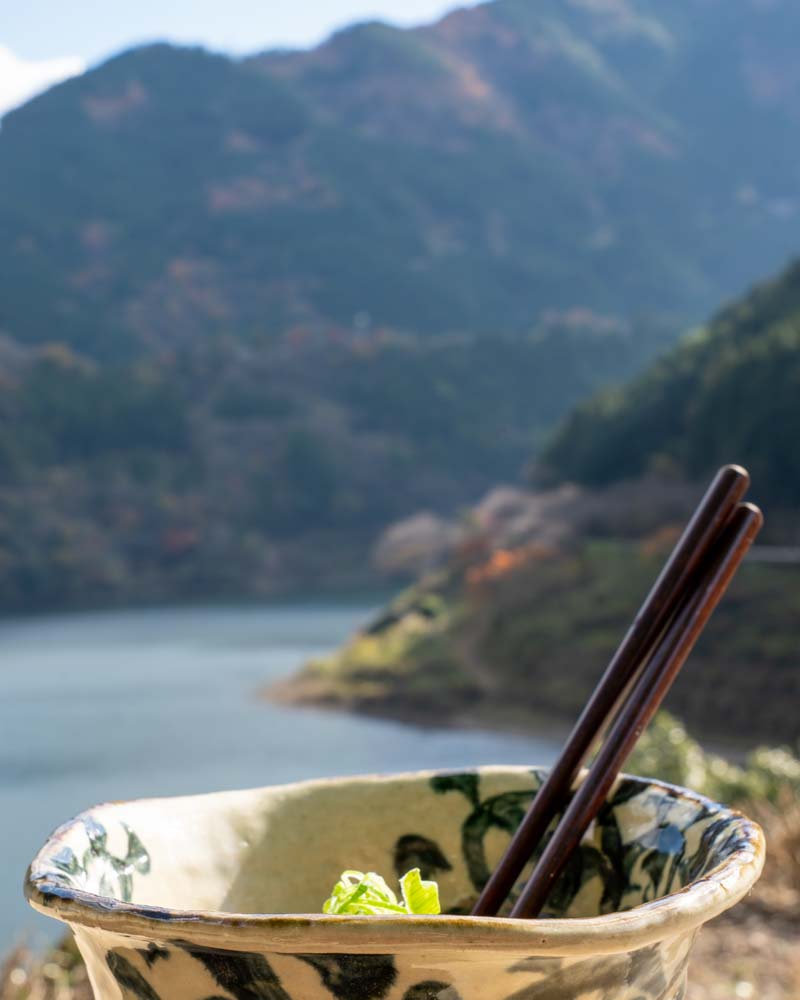
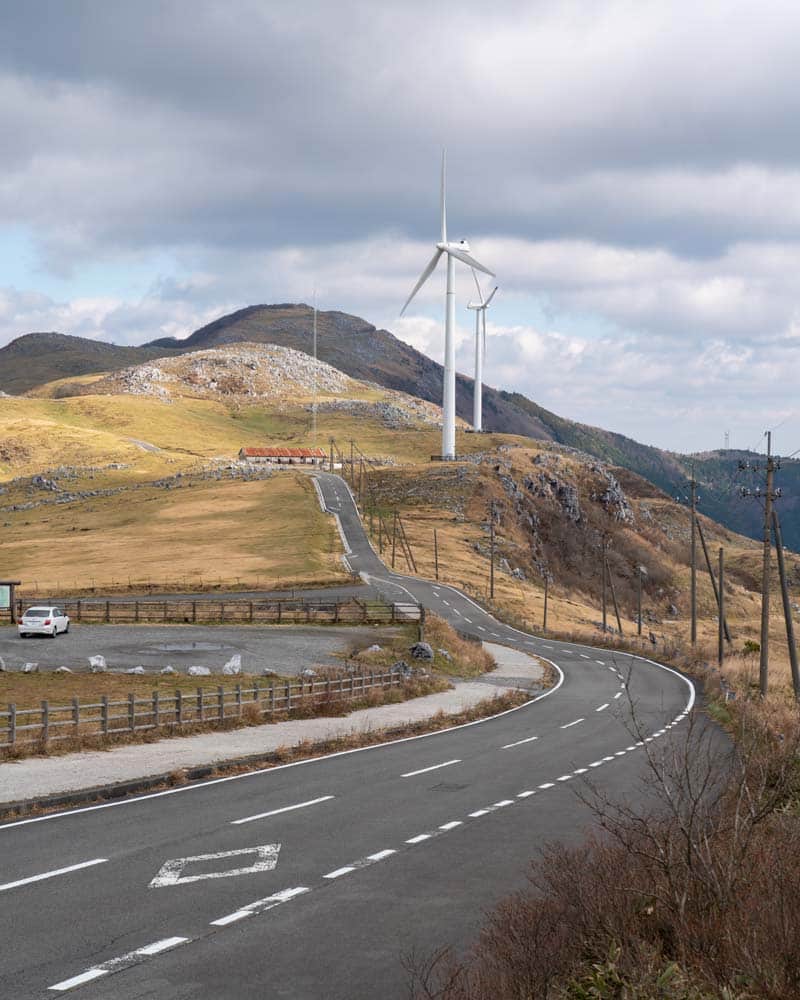
Tree therapy
I wasn’t here to spend the night, though. I was here to sample the Tengu Highlands Forest Therapy Road. While, on first glance, I found the concept confusing, I had to quickly remind myself that Japanese people are some of the healthiest in the world, so if it was good for them, it was more than excellent for slightly overweight me.
With log cabins to stay in and various hiking routes at the high elevation, the main draw here was to escape the polluted cities and breath in the fresh mountains air. As far as the eye could see in all directions, there was the forest, though being winter, at this height, most of the trees were sadly bare. The therapy road takes you higher and deeper into the woodland, with dedicated places for relaxing and meditating, and a range of flora to help you connect with nature.
Our last stop of the day was the picturesque town of Yusuhara. While the streets were quiet and the wooden buildings charming, I couldn’t quite put my finger on why this town felt so relaxing. Keiko, my friendly host, highlighted the fact there were no cables in the streets here, which made it seem so much pretty and organised than many of the other towns and cities in the country.
The main reason we were in Yusuhara though was that I had wanted to visit a library. Yes, reading getting lost in the pages of a book are a staple part of any wellness retreat, but this wasn’t just any library, this was Kengo Kuma’s library.
Kengo Kuma is the mastermind behind the 2020 Tokyo Olympics stadium, and although he does not hail from Ysuhara, some of his most renowned architectural designs are, as it’s here he found much of his inspiration. So much so, a museum is dedicated to his work. The beautifully crafted space is adorned with wood on the outside. Inside, wooden beams protrude from the ceiling, and cubby hole sized rooms adding to the charm of the space.
After enjoying the library, and visiting some of the other charming buildings in the town, such as the ancient wooden theatre, we drove for another hour onto the place I had been most excited to visit, the Shimano River.
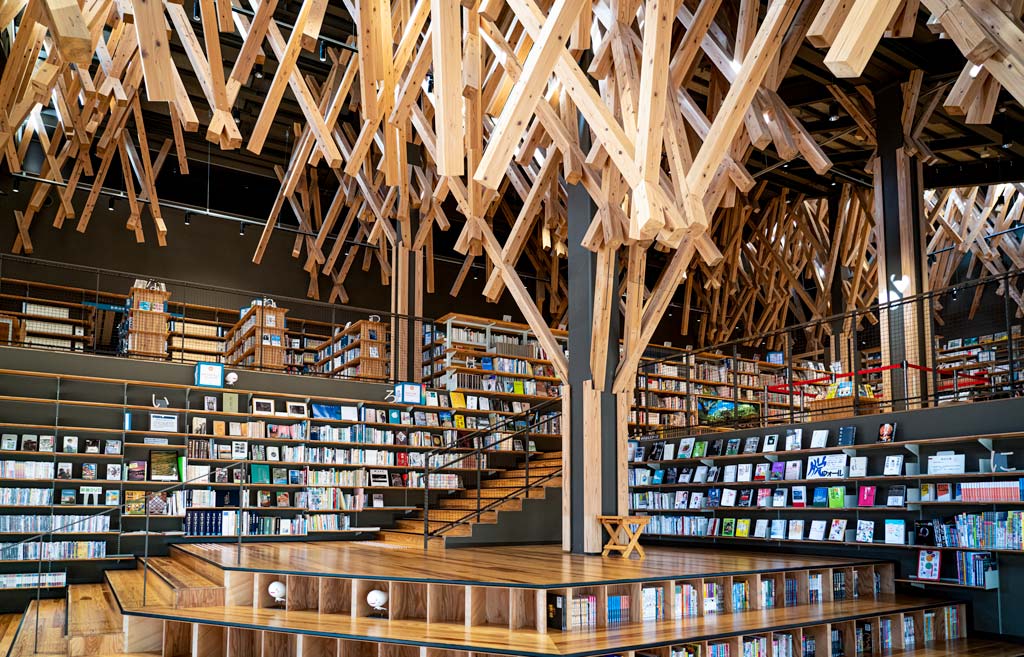
Relaxing rivers, overcoming insecurities
Arriving into Nishitosa, which is accessible via Ekawasaki train station, the sun was just starting to set and illuminated the perfectly still Shimanto river in a range of orange hues, the mountains and trees reflecting like a mirror. I was dying to hit the waters by kayak the next morning, the place where I feel most calm.
The Seira Shimanto Hotel sits in prime position looking down on the village and river, and the panoramic windows of the rooms frame nature beautifully both from the bedroom and the onsen.
While at first getting naked to take a dip had felt quite awkward, by the second time it actually felt quite liberating. It’s such a social norm in Japan, as wellness seemingly trumps body insecurities that it’s well worth getting comfortable with so you can experience the health benefits of using an onsen.
Traditionally, an onsen is a hot spring, but it also covers the inside, or sometimes outside, less natural pools at inns and lodges, who make use of the volcanic waters too. The acidic water is believed to deliver different benefits depending on its mineral properties, but muscle pains and stress are said to be alleviated by taking a dip.
Dragging myself away from the views and relaxing waters, I dined at the hotel restaurant, where a lavish multi-course meal was served, focused around fresh seafood and Katsuo (bonito) – a speciality dish and one of the most famous in the region.
After a blissful nights sleep, broken by the sun cascading through my window where I’d purposefully left the blind open, I devoured my healthy breakfast, now a complete fan of fresh crunchy salad in the early hours, and eagerly headed down to the canoeing centre just moments from the hotel.
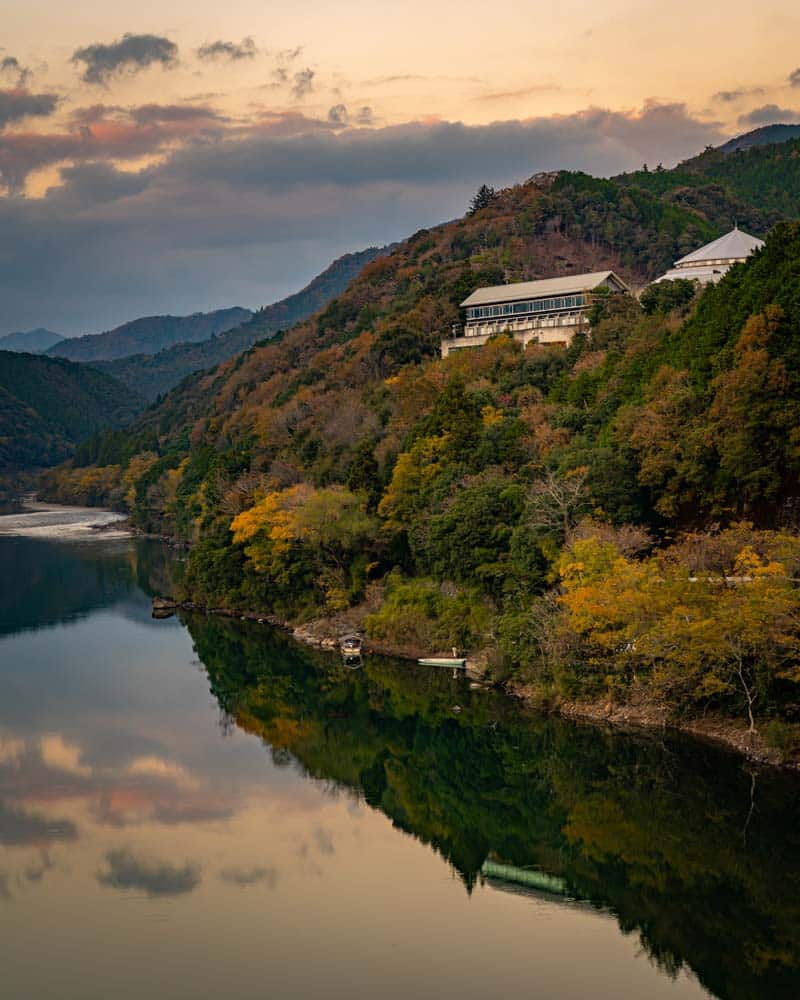
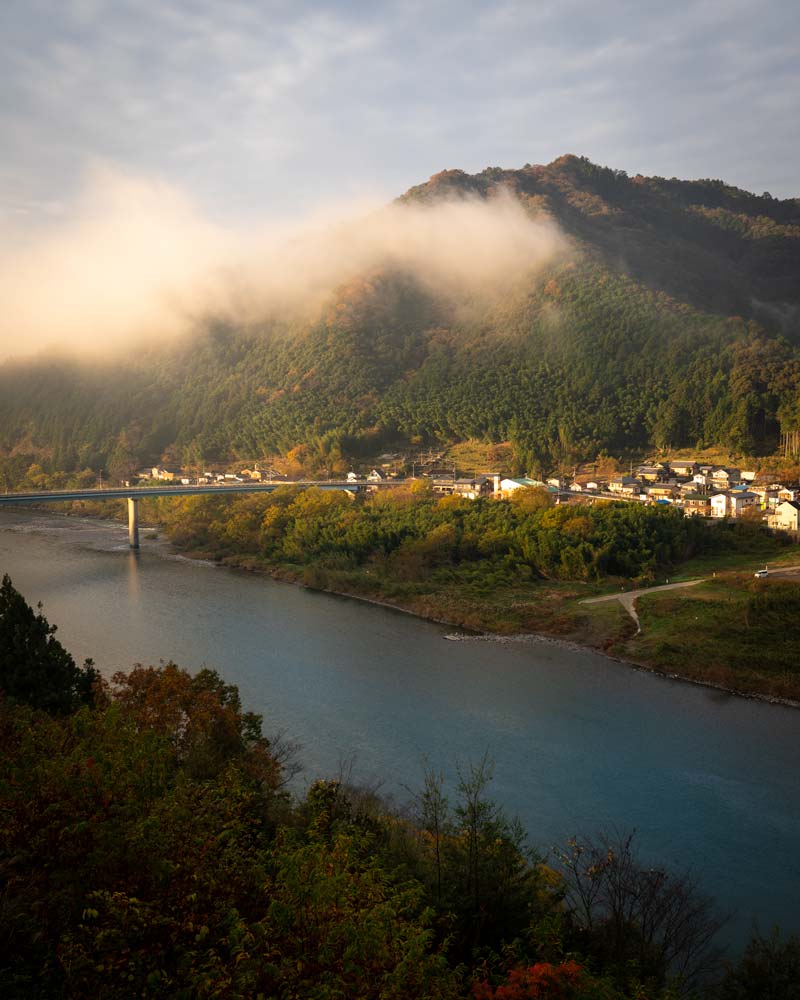
You have plenty of options for exploring the Shimanto river: from having a canoeing lesson to hiring one in solo and heading on an adventure to a pre-agreed collection point where your canoe will be collected. Being on my own and not knowing the area, I opted to go out on the group trip. Luckily, I was the only one signed up that morning, so I got a privately guided experience.
The Shimanto River is very calm and still, except for in small parts where tiny rapids carry you down little dips in the rocks. The water is nearly as bright as Niyodo, though sadly on this day the sun was hiding behind a grey sky, and thus didn’t illuminate the water as I’d seen in many a photo. While this meant I couldn’t photograph the river in all its glory, it didn’t deter me from a peaceful morning. With just the splash of my oar and the birds singing overhead to interpret the silence, I felt like I was in the middle of a meditation session. My happy place is at one with water, and Kochi was obliging me in all the right ways.
I spent the rest of my day in Shimanto cycling along the river, stopping at the occasional rest station, which was perfectly placed and came complete with spotless toilets and dining tables, as you would expect from Japan. The roads were relatively peaceful when the cycling routes faded into them, and the bridges along the river haven’t been built to be fully submersible, so when the water level rises, you can still cycle or drive over them. It wasn’t the season for high waters, so I didn’t see these in action, but it’s another nod towards how the people of Kochi live hand in hand with nature.
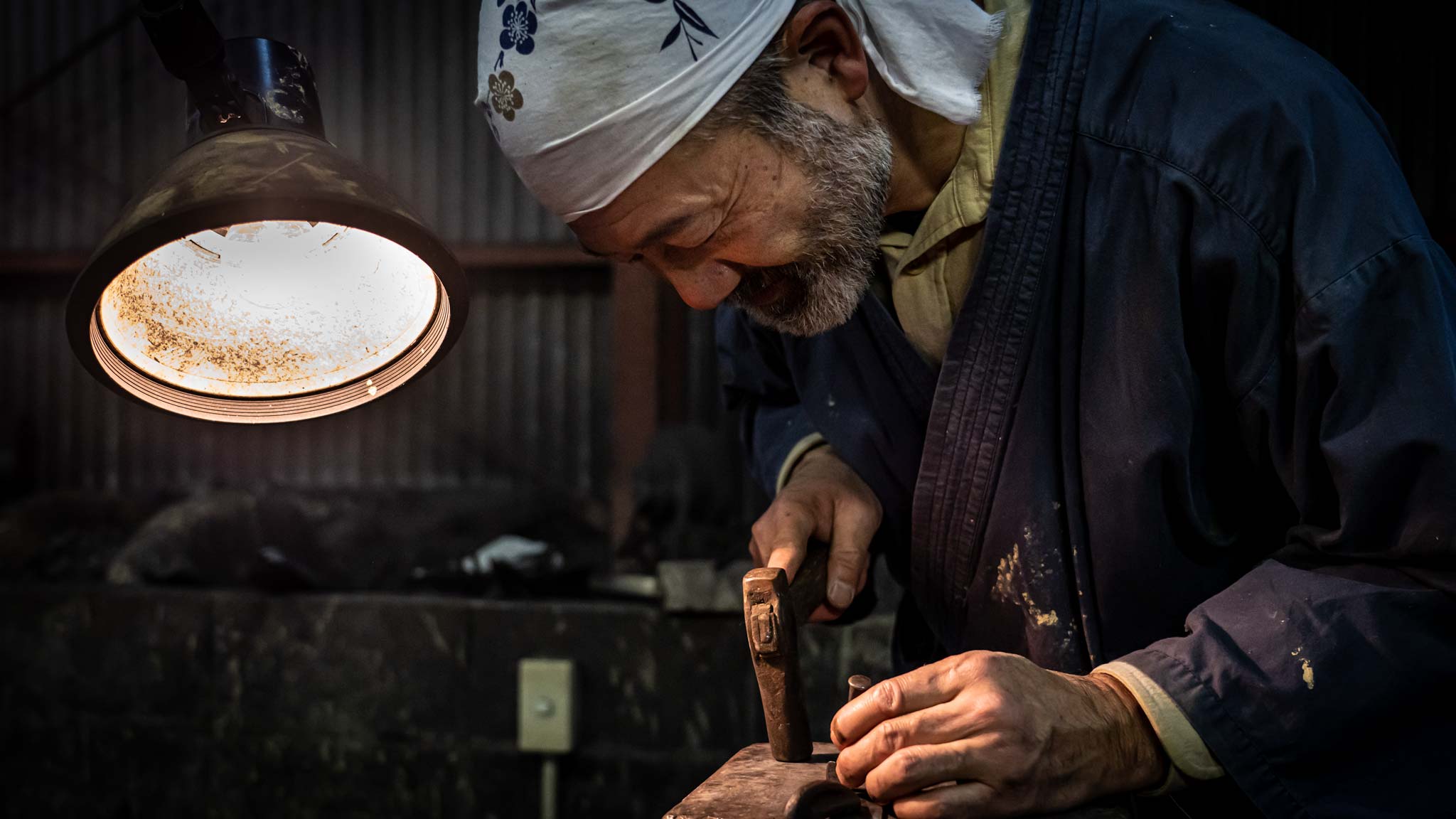
Futons and flames
After a local lunch in a delicious buffet restaurant, where dish upon dish of local treats was laid out, and you paid a simple price for as many visits as you wanted, I crossed the river to Kurogane Forge, for a traditional knife making experience. One of the absolute highlights of my trip, though I’m not sure how much hammering and heating steel falls into the wellness holiday category, but you can read more about my Japan knife making experience here.
After an adventurous day, I deposited my bike in the closest village, a bonus of the local bike hire scheming being the multiple pick up and drop off points, and headed to my home for the evening, Anjuan Ryokan.
Located further down the Shimanto River (closest station Nakamura), Anjuan sits high up on a hill looking down on Nakamura, and across at the Nakamura Castle. While I didn’t have the time to explore the town, I’m told it has Kyoto style to it and is even sometimes known as Little Kyoto.
The Ryokan was as a relaxing experience as I expected, being my first time staying in this traditional type of accommodation. From the moment you are greeted and handed your yukata, a traditional robe you can wear around the hotel, to settling into the ridiculously comfortable futon style bed in your room, you’ll feel relaxed. With a delicious banquet meal served at a low table in a private room, to the onsen and tranquil music in the lounge, this was a delightful place to spend the night and recharge after an energetic day, so much say I basically fell asleep at the dining table.
Nearly at the far south of Kochi Prefecture, it would have been rude not to complete the route down the region, so, returning to the ocean the next day, I continued down to Tatsukushi (no train, accessible by Tatsukushi bus), home to a quirky looking underwater observatory I had spotted on Atlas Obscura.
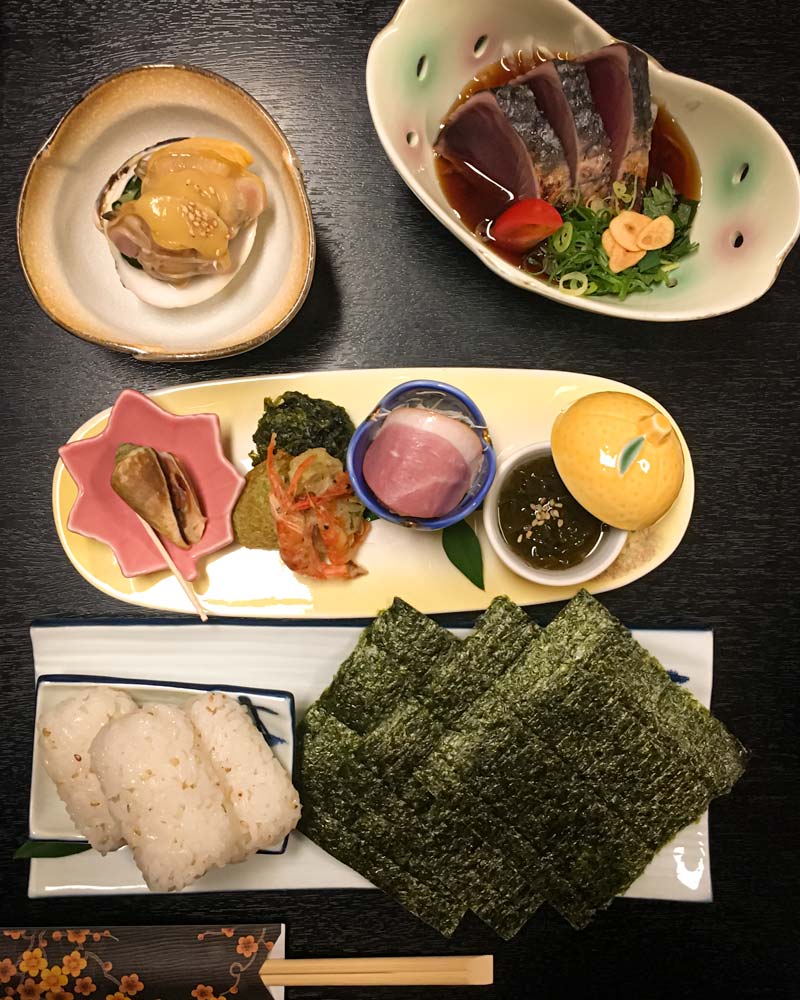
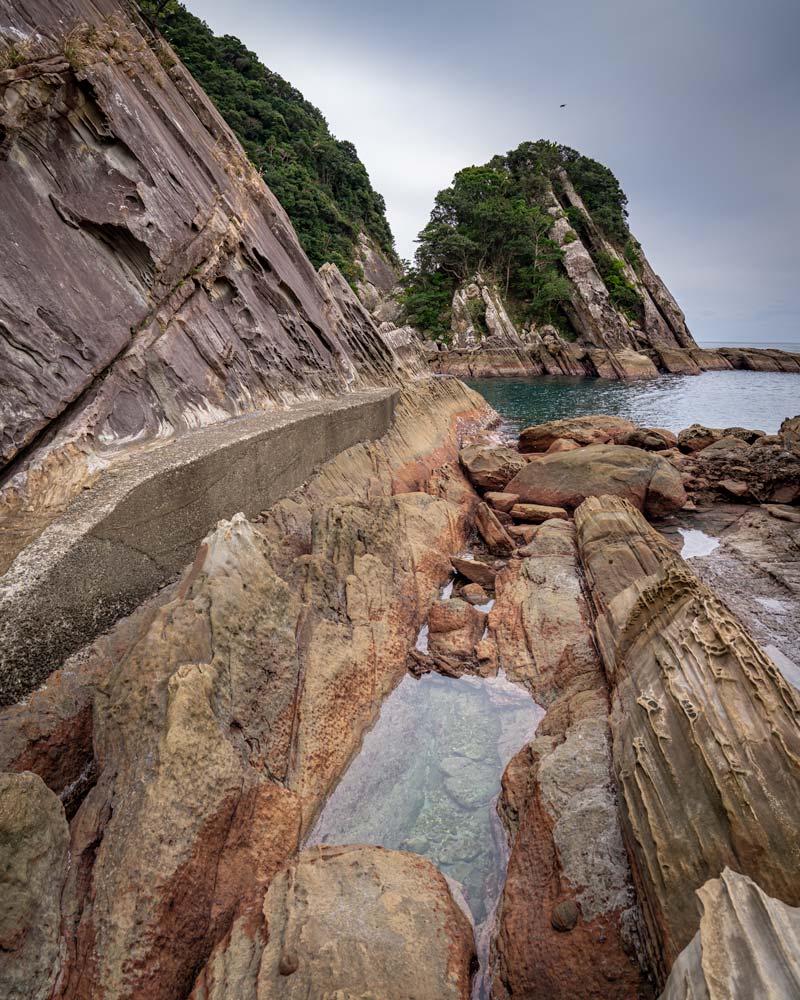
Tataki and tides
There is plenty more to this underwater focused spot though than the retro Ashizuri Observation Tower, although it really is rather fantastic. Dating back to 1972, it’s one of just a few remaining in the country, and as it goes underwater, it means no animal cruelty as the fishes and sea life are all in the wild, although I think some feed may be used to bring them closer. Down at the bottom of the tower, portholes give you a vantage point into the ocean.
There are also glass bottom boats you can board, that take you to other parts of the park and rugged coastline. Many of the rock formations have stories attached, and names, depending on their shapes. Formed by millions of years of sea compression on the mud and sandstone, similar to Muroto, here you’ll also spot dark coloured markings, which have been made from ancient sea lava.
For another slice of a wellness retreat in Japan, embed yourself on the sands of Sakura Beach, a popular destination in the summer months.
It seems fitting that Japan would have an official underwater marine park, something of a wellness destination for sea life, and colourful corals. It’s also a well-known destination domestically for scuba diving if you want to go beyond the glass-bottomed boats.
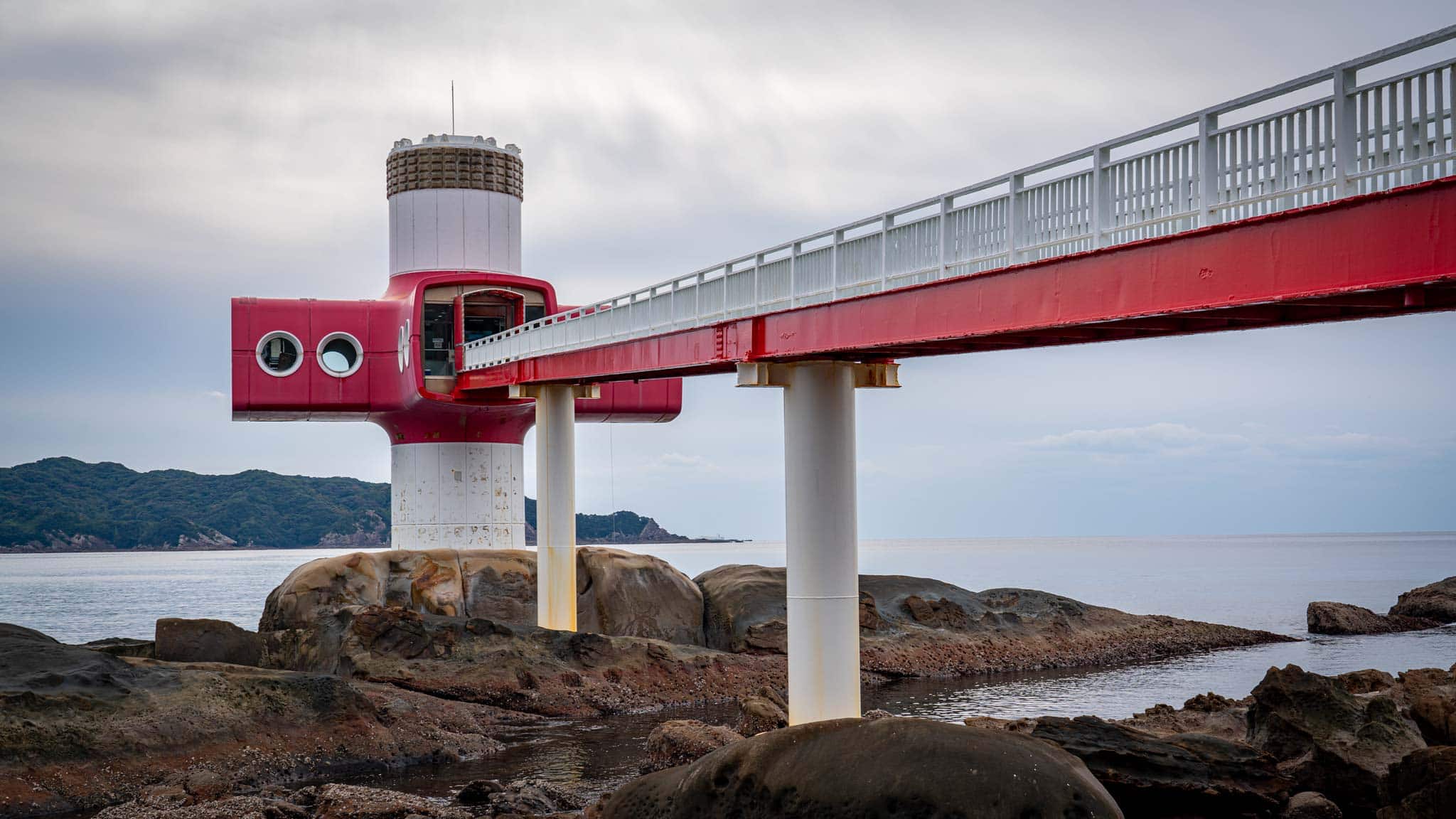
Further up the coast, back towards Shimanto, at the Irino Fishing Port, you can also board boats to watch whales and dolphins in the wild. On a side note, as it would be wrong for me to ignore it, in Muroto, there was a dolphin park, that although billed as an NPO (not for profit and research organisation) offers Dolphin experiences in small pools, and breeds them, which I am very actively against. Sadly, even where I live in Portugal, these experiences still exist, and I believe that these animals should be in a wild.
Stopping for a more local version of Katsuo no Tataki, the famed seared fish dish at Kuretaishomachi Market on route back to Kochi City. It was made even more special by the chance to cook it myself, in the flames of hay, at this traditional fish market.
Calm in the city
My final hours in Kochi City, not exactly a large city by Japanese standards, but enough to shake me from the nature induced haze I’d been in, were spent at the Kochi Castle enjoying the seasonal Kochi teamLab digital art exhibition. With relaxing music and innovate light displays, before getting my full of all the local dishes, including a Matcha beer no less, at the buzzing Hirome Ichiba Market, popular with both locals and tourists alike.
Sadly, time was nearly by on my wellness retreat in Japan, although I hadn’t realised that’s what it would be when I arrived. I took the last onsen dip in my city-centre hotel and headed out to the weekly Sunday Market, a calming affair thanks to the traffic being diverted, and friendly local farmers selling their produce directly. I’d been advised I couldn’t leave the prefecture without sampling the fried sweet potato dish from this very market, and I was more than happy to oblige that recommendation.
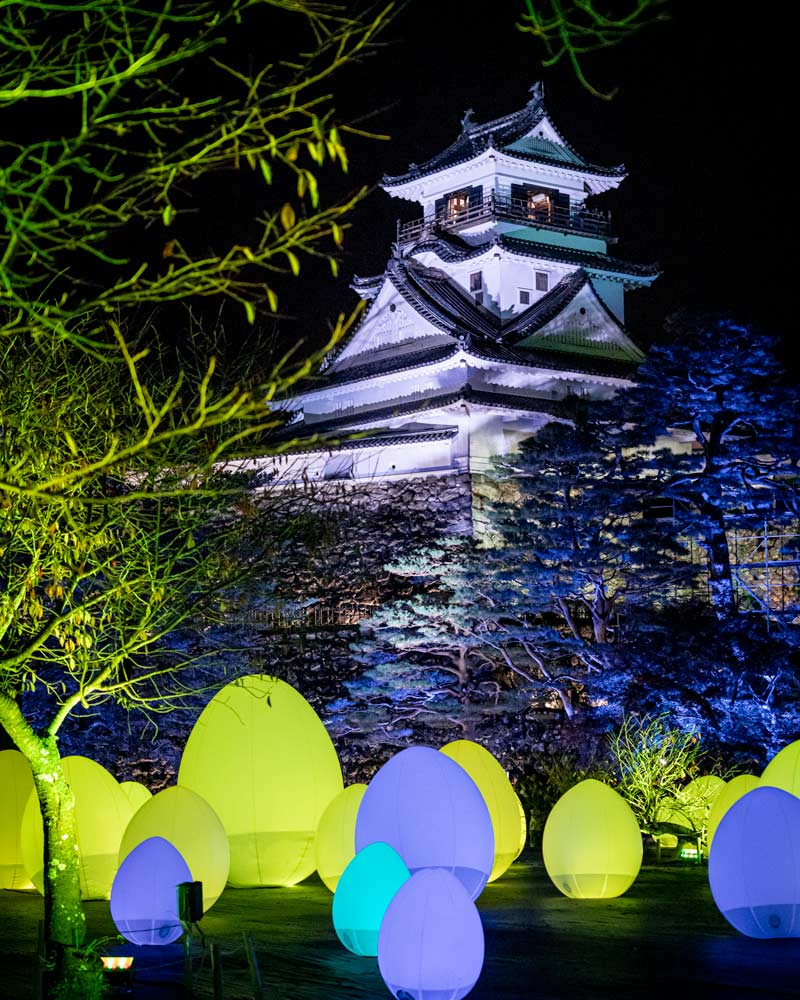
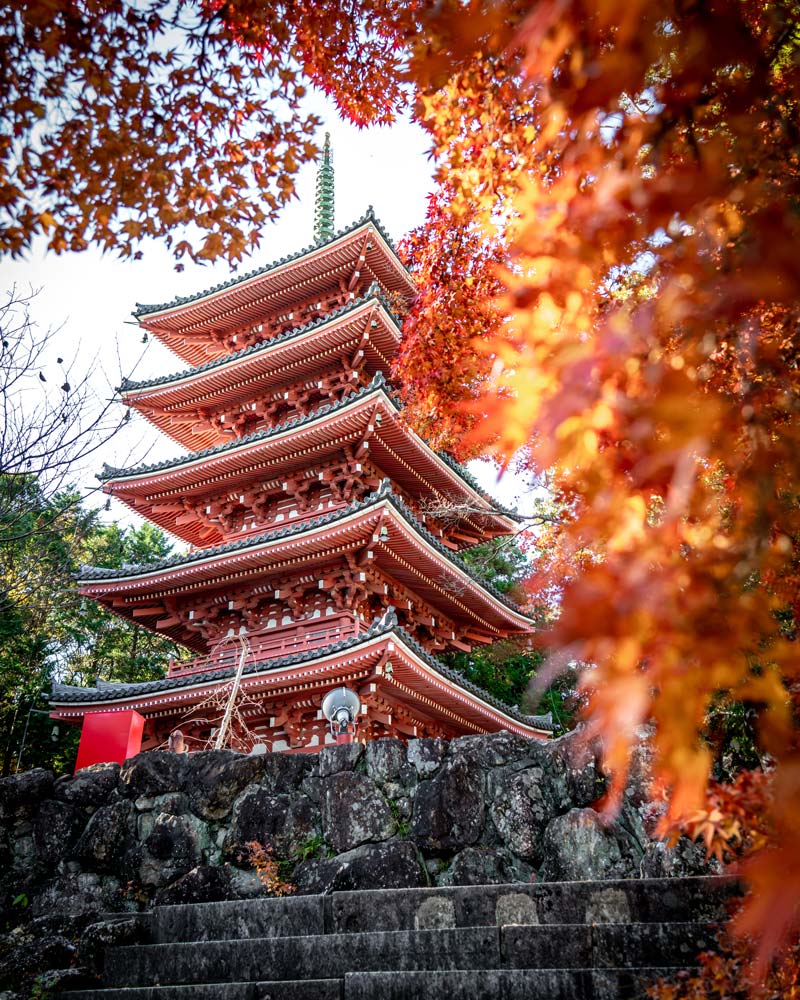
On route to Kochi Airport, we stopped off at Chikurinji Temple, another on the long-distance pilgrimage trail and located next door to the Botanical gardens.
This five-tiered red pagoda was beautiful and made even more magical by its framing of bright red and orange leaves dancing delicately in the wind.
What made this temple my favourite though was the small crowd in front of it, in their white outfits and conical hats, peacefully reciting prayers, I was so happy to witness the pilgrims from the trail at one of their special sites
By the time I left Chikurinji Temple, I felt complete calmness, a state of Zen almost. What was that word?
Kintsugi.
Sure, there was no golden glow piecing me back together, but I could see from the smile in the car mirror that I was coming home repaired, crack-free, and relaxed.
Unknowingly, the nature and niceties of Kochi had worked together to perform a human Kintsugi on me. Kochi was the Japanese wellness retreat I hadn’t know I needed.
The chaos of the world I knew had been replaced by calm, and albeit it temporarily, I knew there would always be mother nature’s medicine waiting patiently here in Kochi for my return.
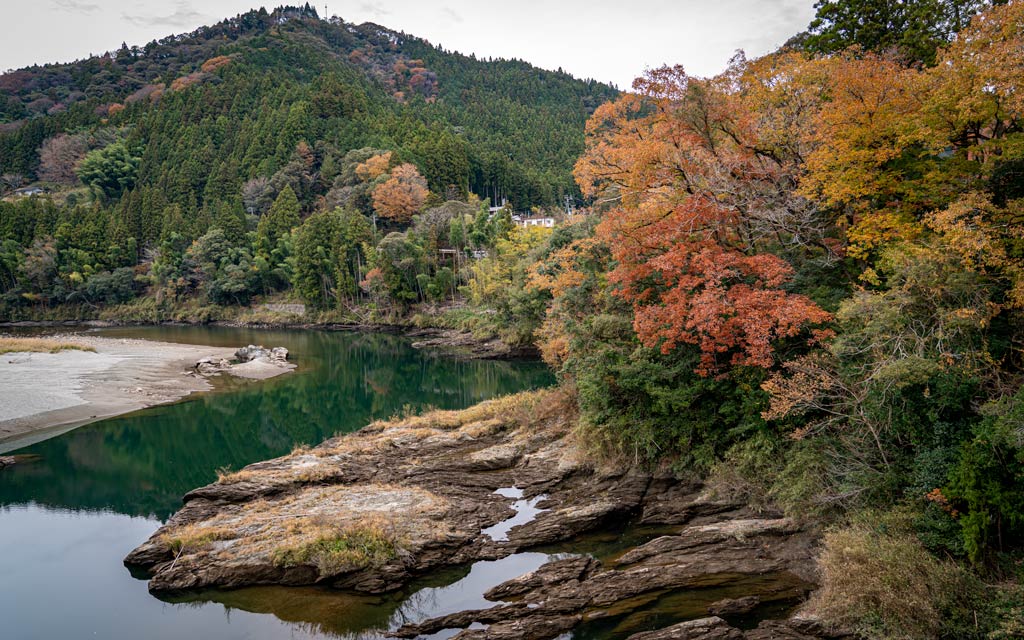
These are just a sampling of some of the wellness activities on offer in Kochi, Japan. Other options include the wooden cabins of Mont Bell Outdoor Village in Motoyama, a new wellness village destination with water sports and activities along the river. Or the greenery of the Aikawa Tanada terraced rice fields, where you can hike amongst nature before visiting award-winning Sake breweries, or the regions oldest winery. Visiting in the off-season meant not all activities were possible for me to enjoy personally, but please read my Kochi Japan Travel Guide for a full overview and to help you plan your trip to this beautiful region of Japan.




To visit Kochi is on my bucket list now. I will surely visit japan one day. I highly appreciate your hard-working skills as the post you published have some great information which is quite beneficial for me.
Hello Dan, I read your blogs. You are an great writer.
Thanks!
All these beautiful photos allure me to visit Kochi even more. Even though it’s not possible for me to visit there myself for some time being, but I am going to share this post with my friend who is there in Japan.
Fantastic news Surya, I hope you can visit yourself one day too :)
I loved the post. It is always amazing to me as to how mother nature can ‘cure your ills’. When we have traveled continuously for several months, we always try to seek out a relaxing destination where we can slowly rejuvenate. Kochi sounds like one of those perfect places. Your photos are amazing.
Thank you so much – it’s always so important to enjoy the slow and relaxing too.